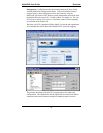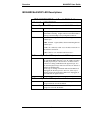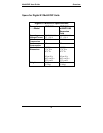
MultiVOIP User Guide Overview
39
Supplementary Telephony Services. This is available in 5.04 but not 5.02c.
The H.450 standard (an addition to H.323) brings to voip telephony more of
the premium features found in PSTN and PBX telephony. MultiVOIP units
offer five of these H.450 features: Call Transfer, Call Hold, Call Waiting, Call
Name Identification (not the same as Caller ID), and Call Forwarding. (The
first four features are found in the “Supplementary Services” window; the fifth,
Call Forwarding, appears in the Add/Edit Inbound phonebook screen.) Note
that the first three features are closely related. All of these H.450 features are
supported for H.323 operation only; they are not supported for SIP or SPP.
RCV XMT C OL L NK
Ethernet
Boot
Power
ISDN 1
ISDN 2
ISDN 3
ISDN 4
D
XM T RCV XMT RCV
Ch 1 Ch 2
D
XMT RCV XMT RCV
Ch 3 Ch 4
D
XM T RCV XMT RCV
Ch 5 Ch 6
D
XMT RCV XMT RCV
Ch 7 Ch 8
Figure 1-11: MVP-410ST/810ST Chassis
ISDN BRI MultiVOIP Front Panel LEDs
LED Types. The MultiVOIPs have two types of LEDs on their front panels:
(1) general operation LED indicators (for power, booting, and
ethernet functions), and
(2) channel operation LED indicators that describe the data traffic and
performance in each VOIP data channel.
Active LEDs. On the MVP810ST, there are four sets of ISDN-operation
LEDs. On the MVP410ST, there are two sets of ISDN-operation LEDs. Each
set contains one “D” LED and two sets of channel operation LEDs (XMT and
RCV).
Figure 1-12. MVP-410ST/810ST Front Panel


















